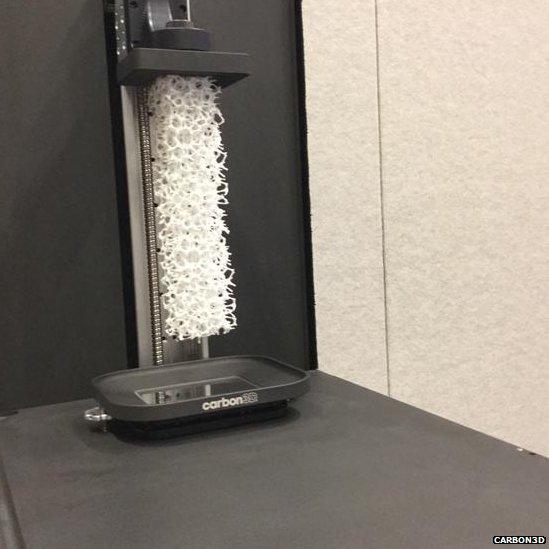TED 2015: Terminator-inspired 3D printer 'grows' objects
- Published
WATCH: The Carbon3D printer uses a pool of resin to make its objects 'grow'
A 3D printing process that harnesses light and oxygen has been demonstrated at the Ted (Technology, Entertainment and Design) conference in Vancouver.
Carbon3D said its "game-changing" process could make objects such as car parts, medical devices or shoes.
The technique was inspired by the film Terminator 2, in which the T-1000 robot rises from a pool of metallic liquid.
One independent expert told the BBC the technology showed huge potential, if the company's assertions stood up.
"It's not unusual for huge claims like this to be made," said James Woodcock, group editor for TCT Magazine.
"But as it's renowned experts working on it, it gives it some gravitas."
Mushroom growing
On the Ted stage, the Carbon3D machine produced a plastic ball from a pool of resin in 10 minutes.
"It would traditionally take up to 10 hours to print this," Carbon3D chief executive Prof Joseph DeSimone told the audience.
He said that current 3D printing methods had some fundamental flaws.

The printer could be used to make replica bones or other medical appliances
"First up, the name is a misnomer. It is really 2D printing over and over again," he said.
The process is also often very slow.
"There are mushrooms that grow faster than some 3D-printed parts," he joked.
And finally the objects created by traditional 3D printing are often mechanically weak because they are made up of multiple layers.
His method is 25 to 100 times faster and can print solid final parts. It can, he said, potentially be up to 1,000 times faster.
It works by applying different levels of light and oxygen to a pool of resin. Light hardens the resin, while oxygen stops hardening.
By intricately controlling levels of each, the resin can be forced into complex shapes.
In the field
Possible uses for objects include medical stents that could be made-to-measure in medical rooms and teeth printed "while the patient sits in the dentist's chair", he said.
Currently the printer can only work with polymer-based materials but Prof DeSimone told the BBC his firm is "working on" materials beyond that.
There are already several printers being tested in the field - by an unnamed automotive firm, an athletic apparel company and a research lab.
Carbon3D hopes to have its product out commercially "within a year".
Mr Woodcock from TCT Magazine said the demonstration showed the need for companies in the industry to continually work on new technology.
"The whole 3D printing industry is on a knife edge - there' so much still to come. Even the biggest and most established companies are only a couple of announcements away from being redundant."
- Published22 May 2013
- Published18 August 2013